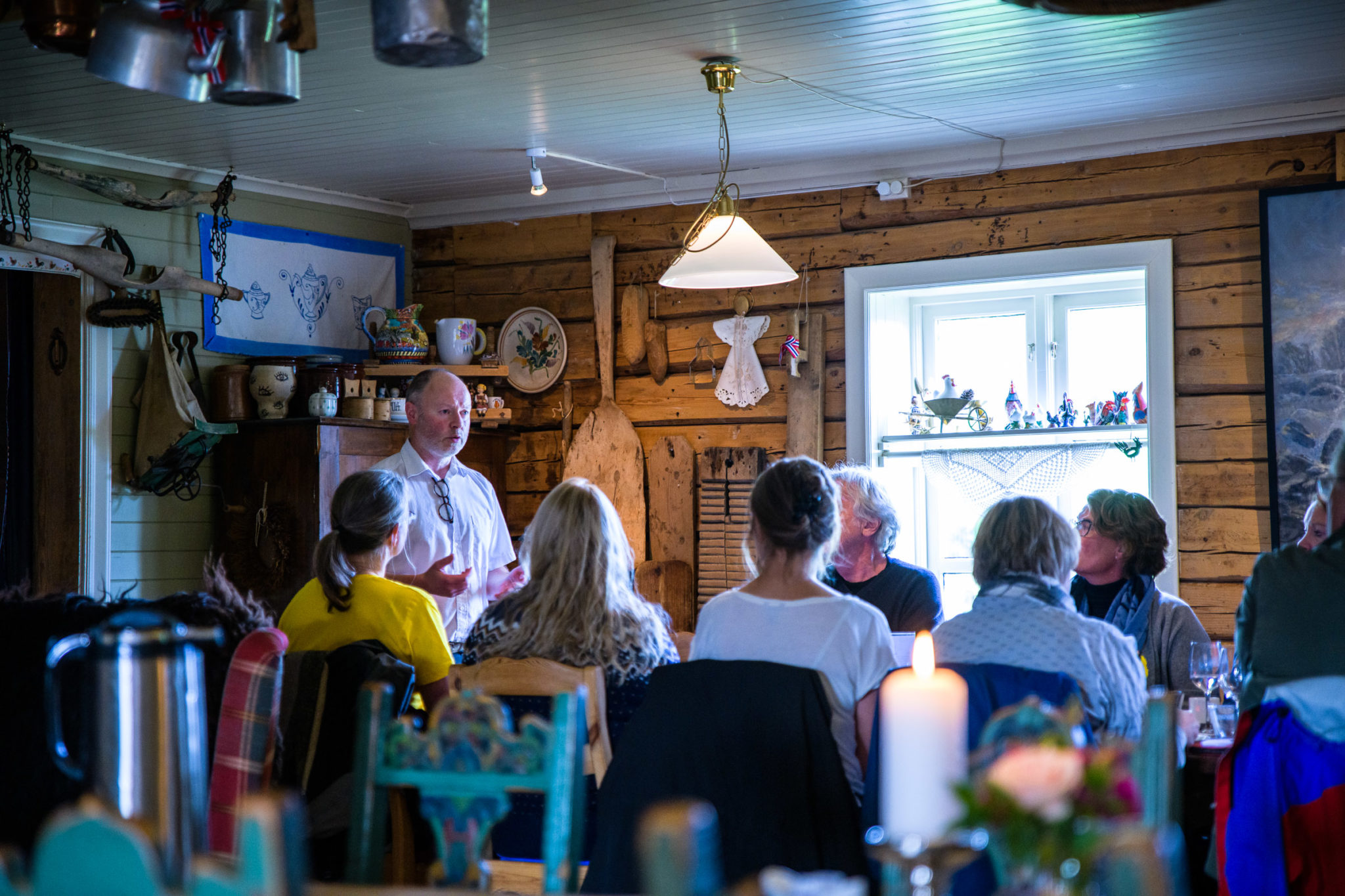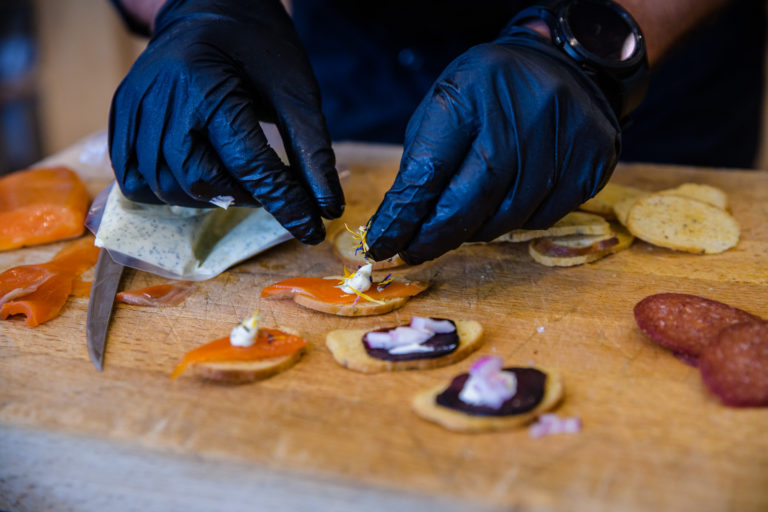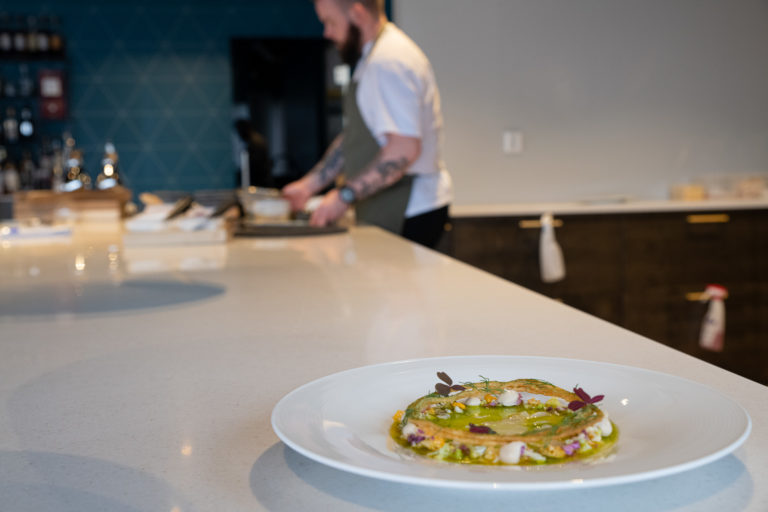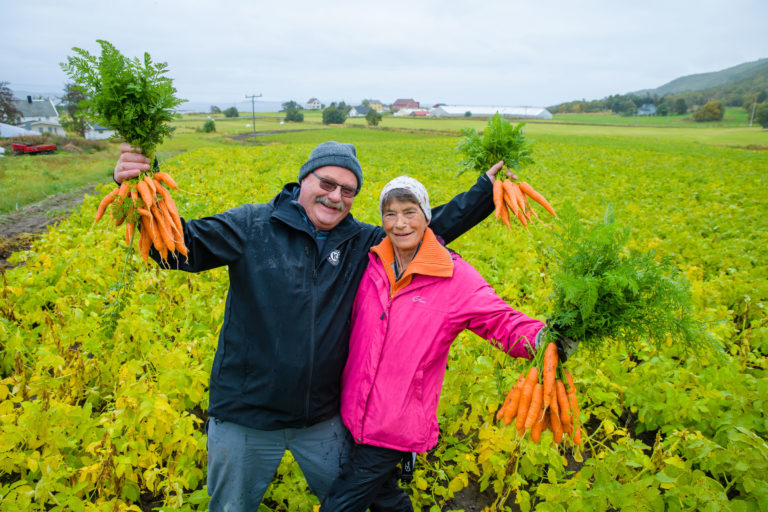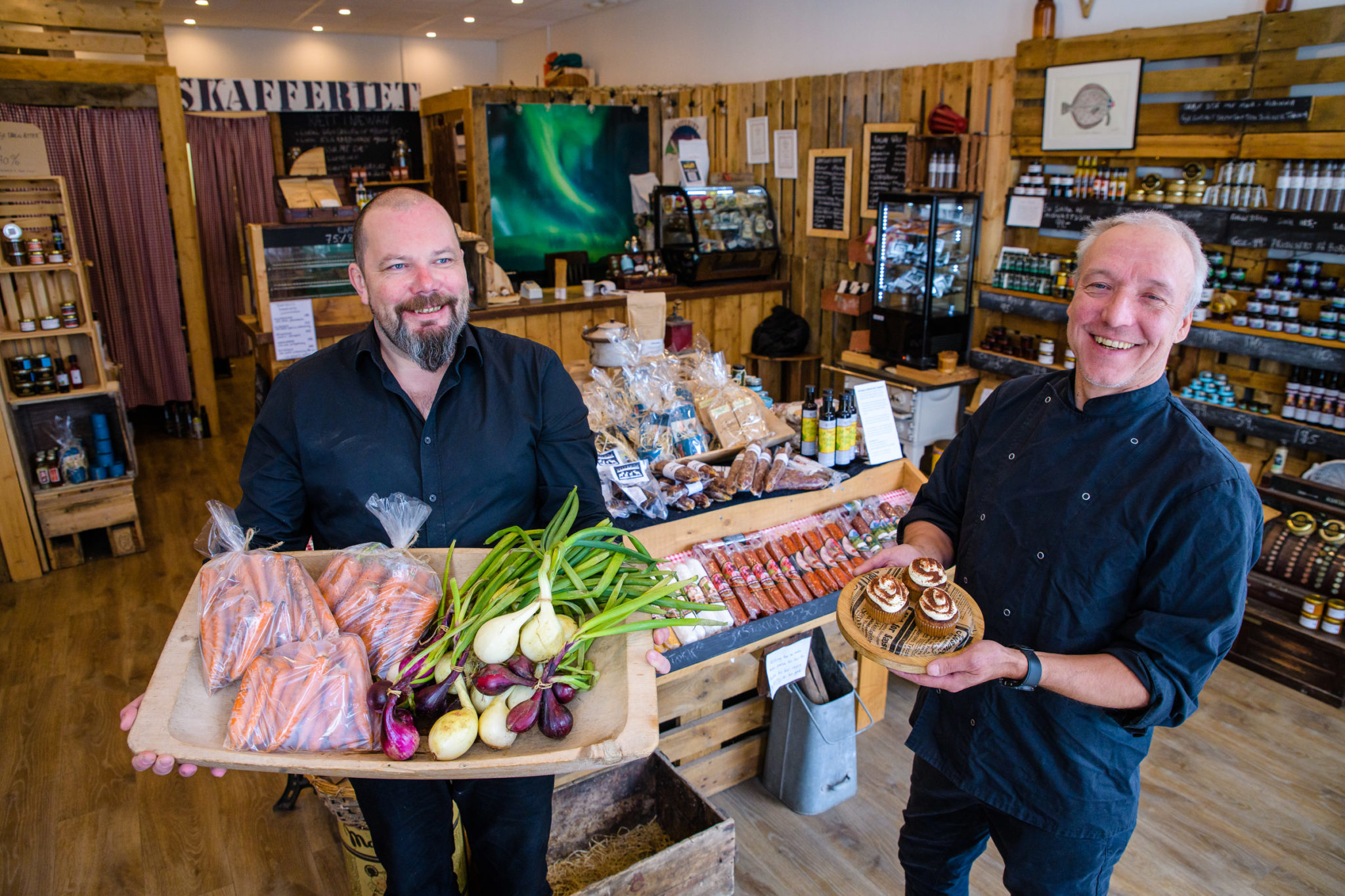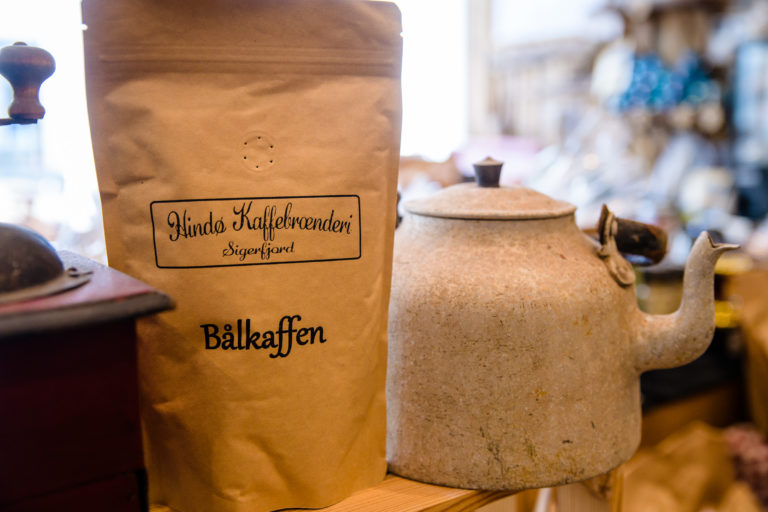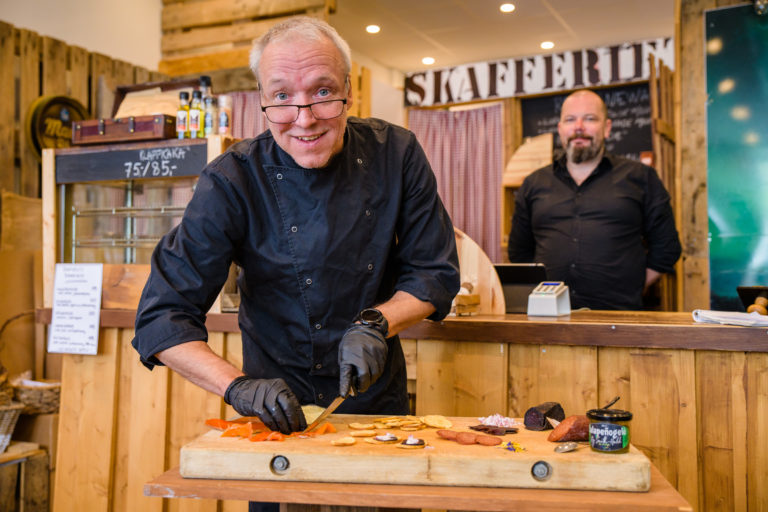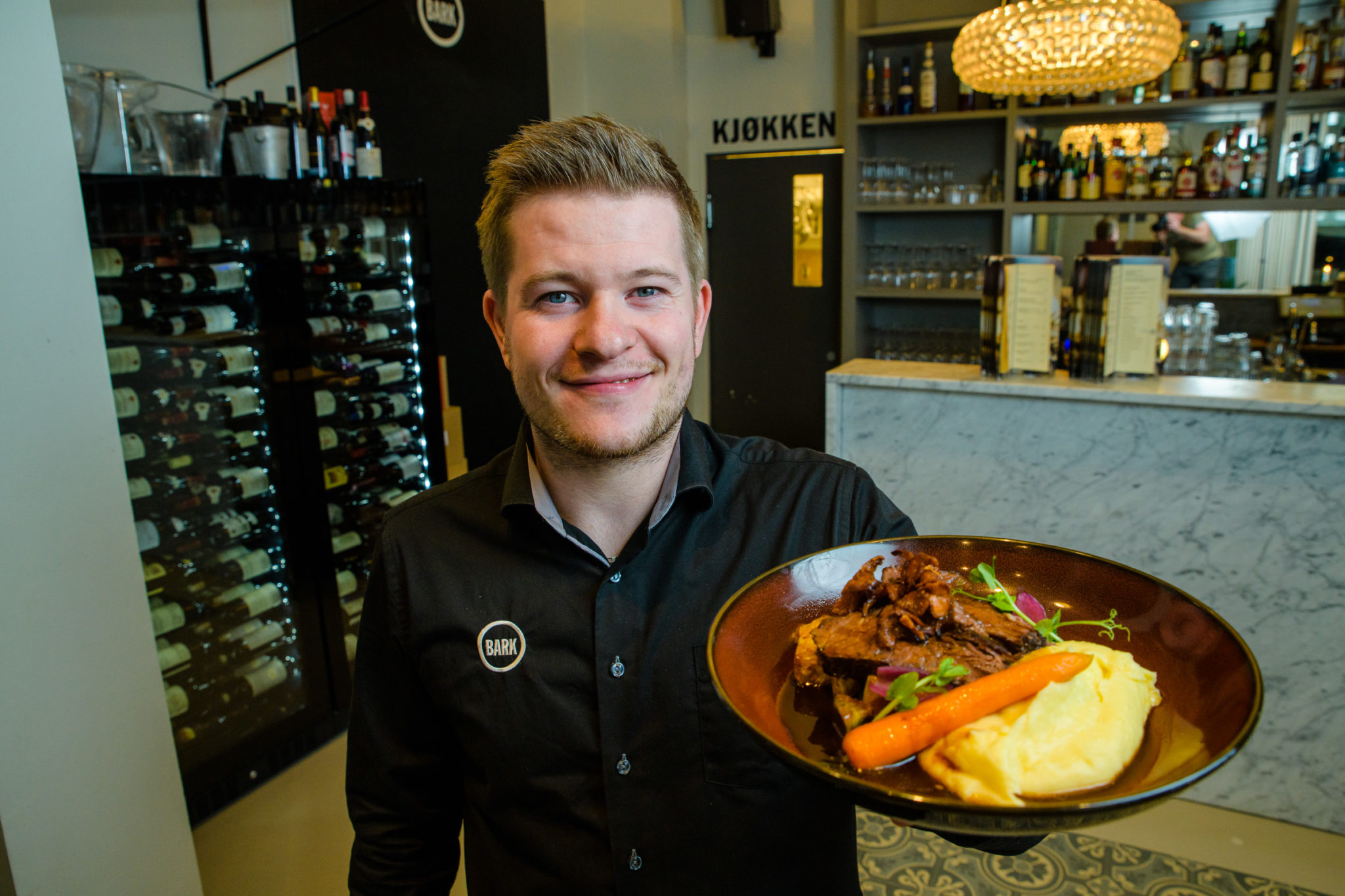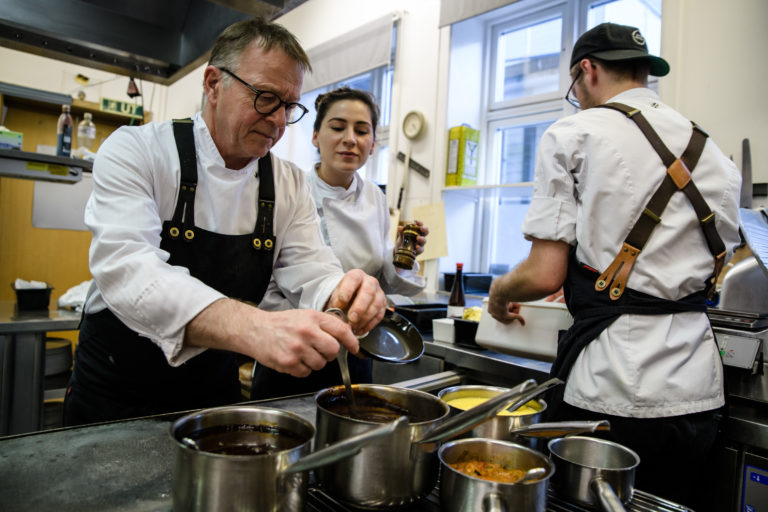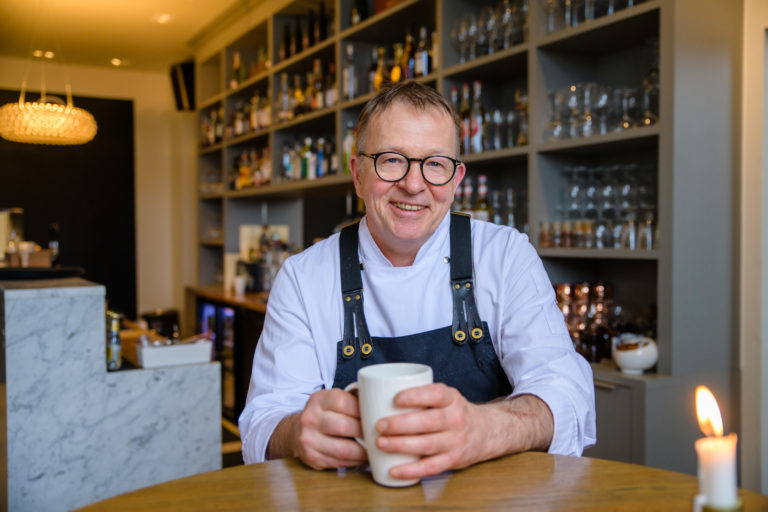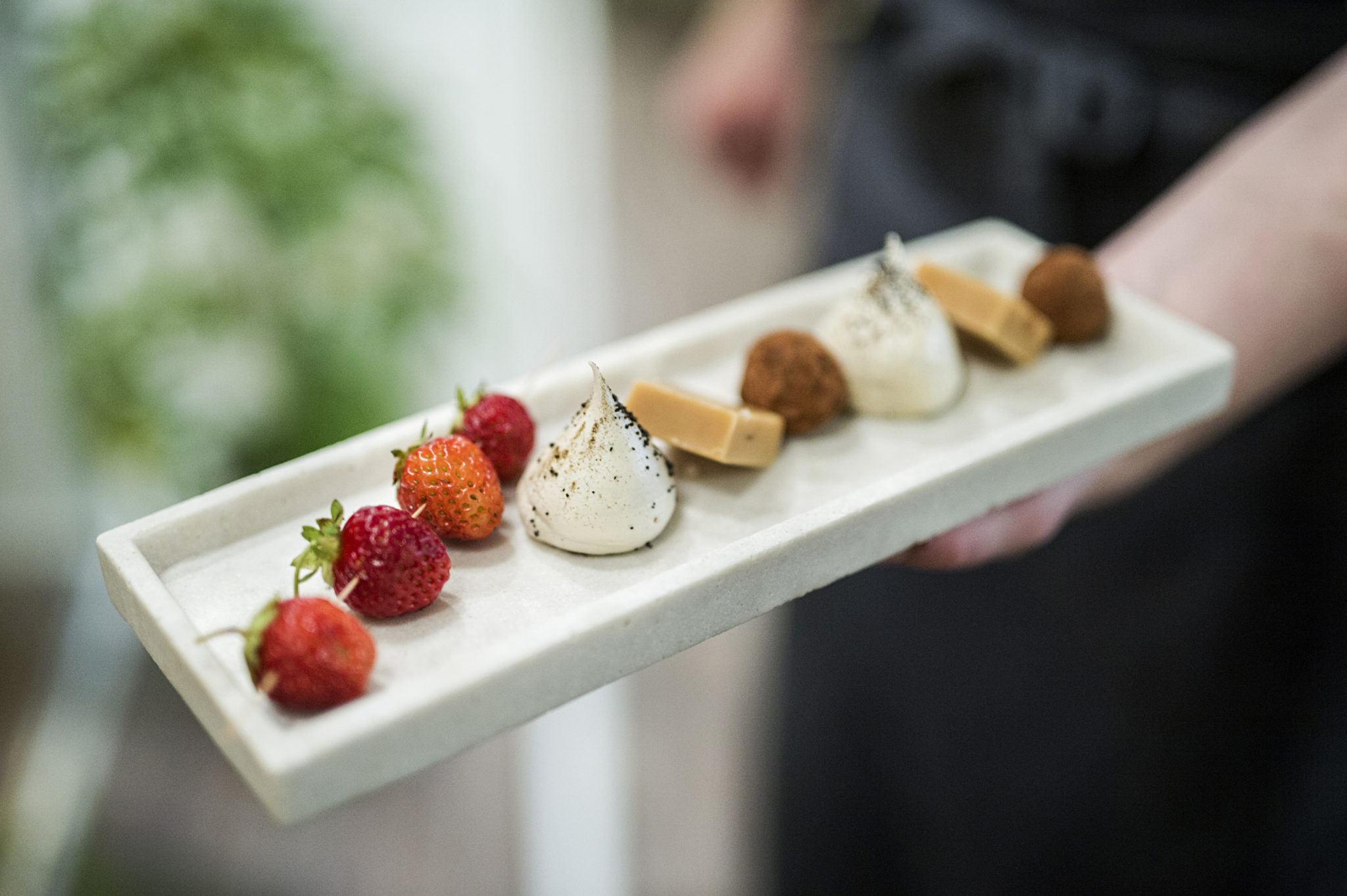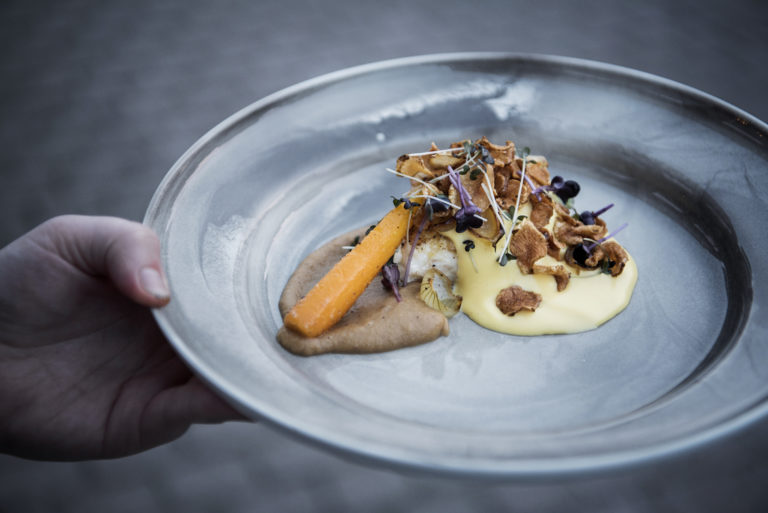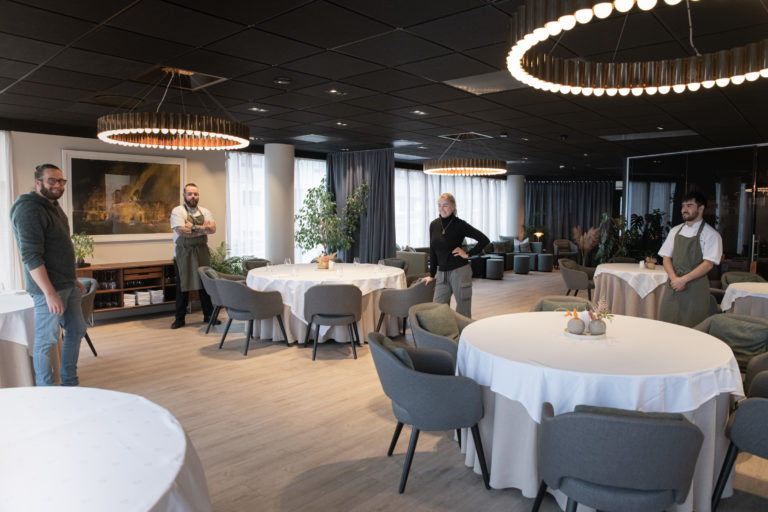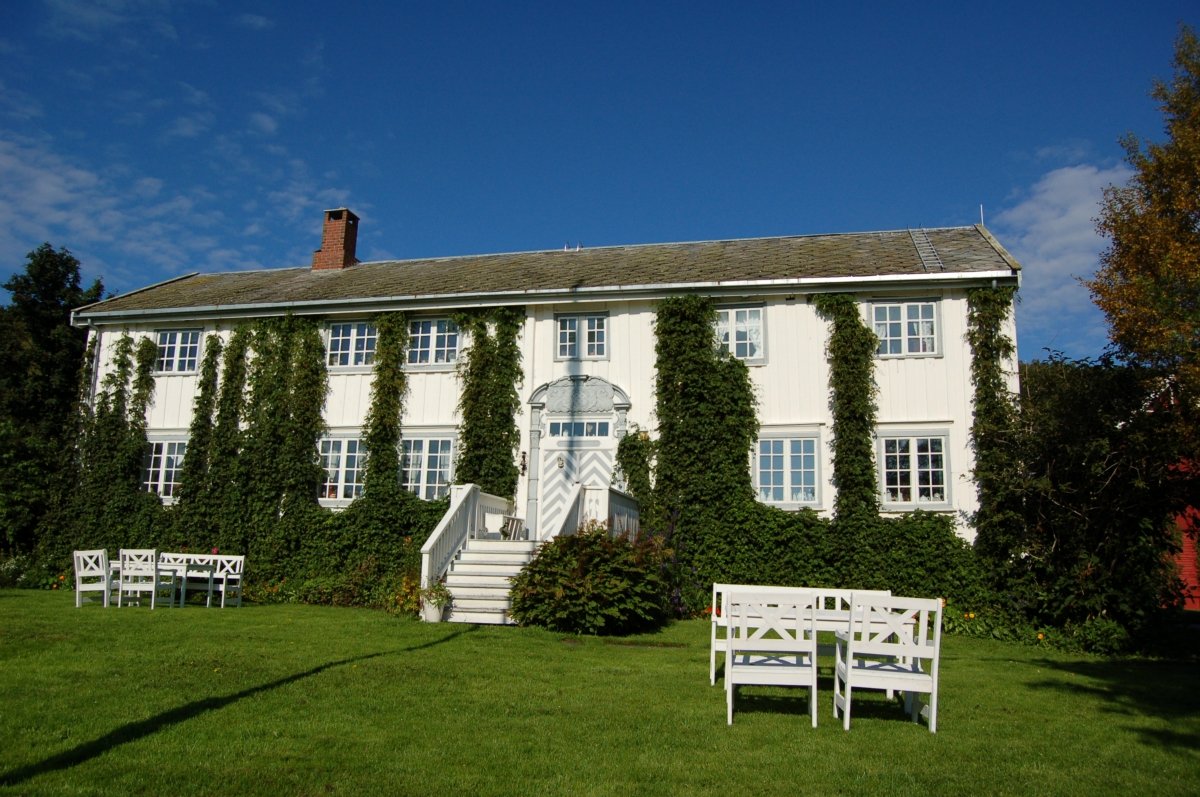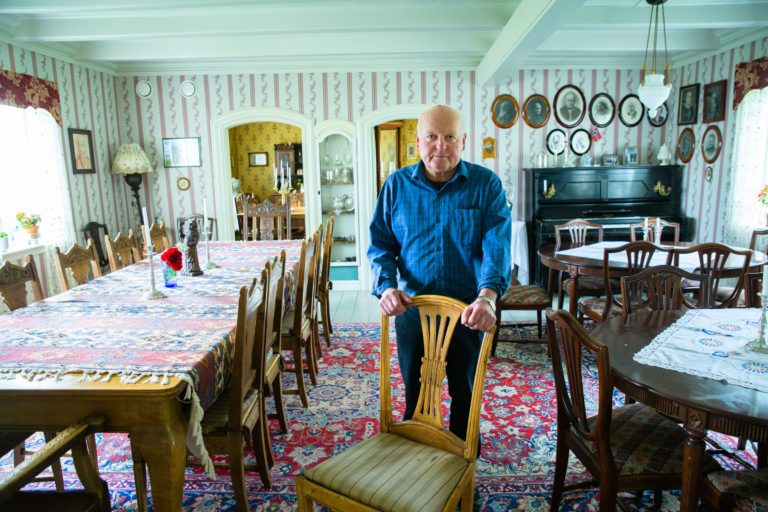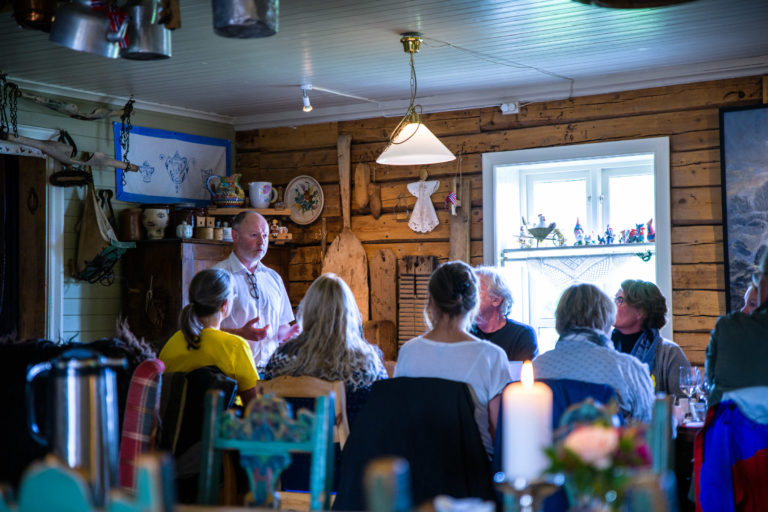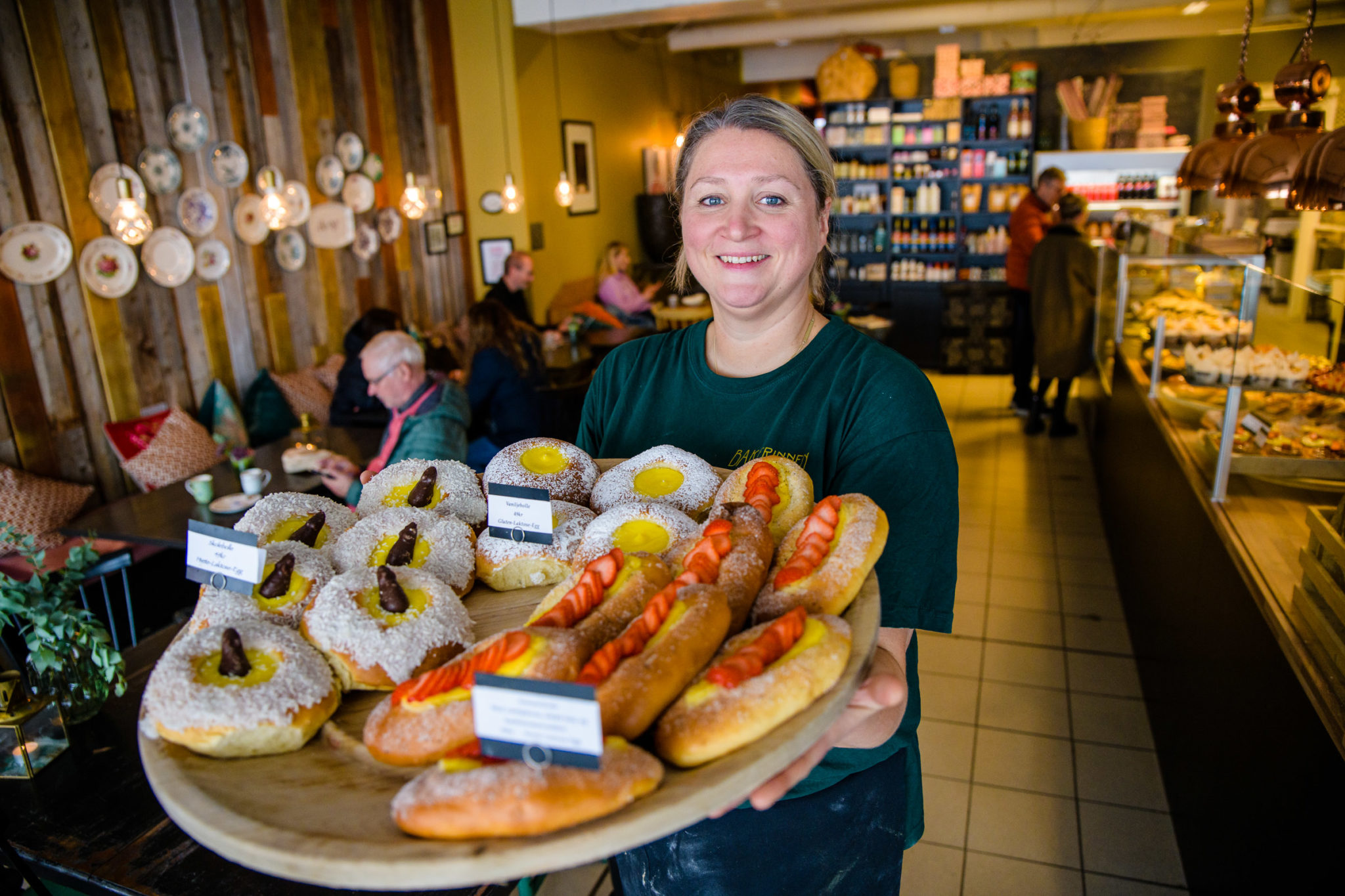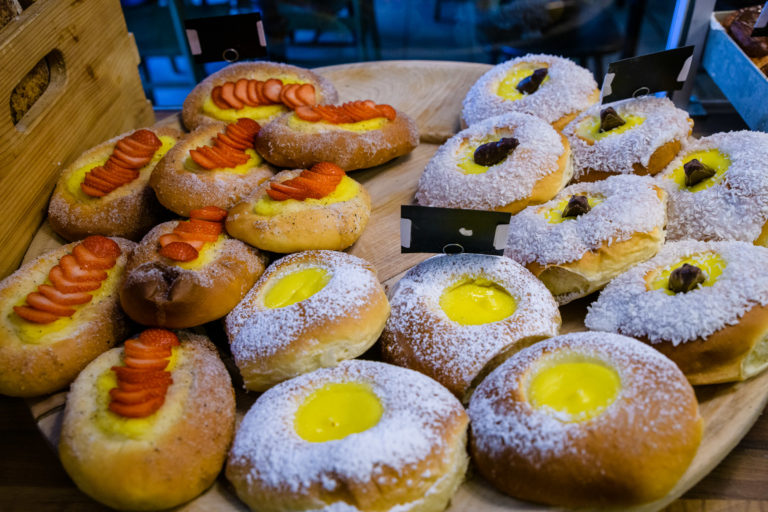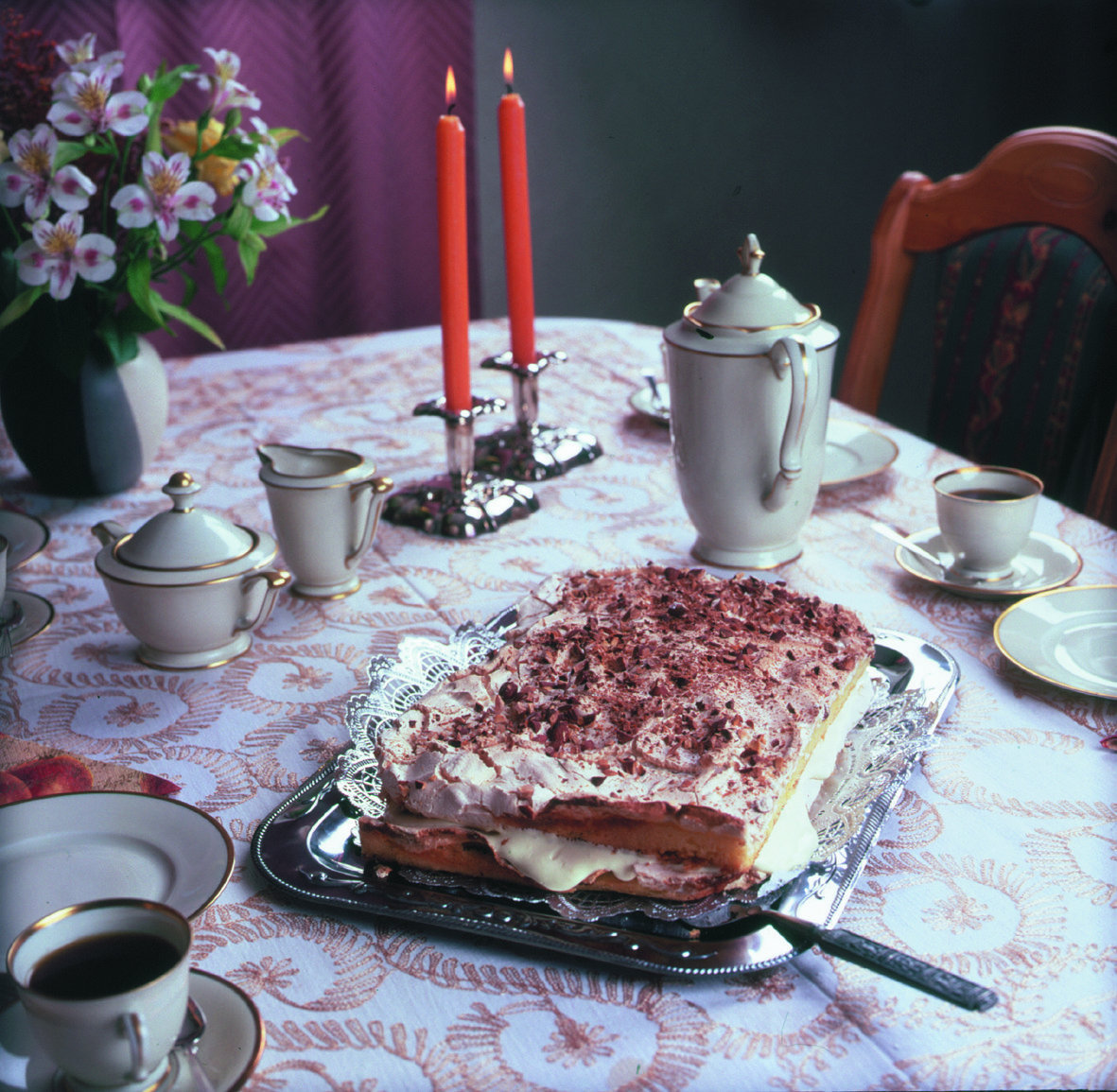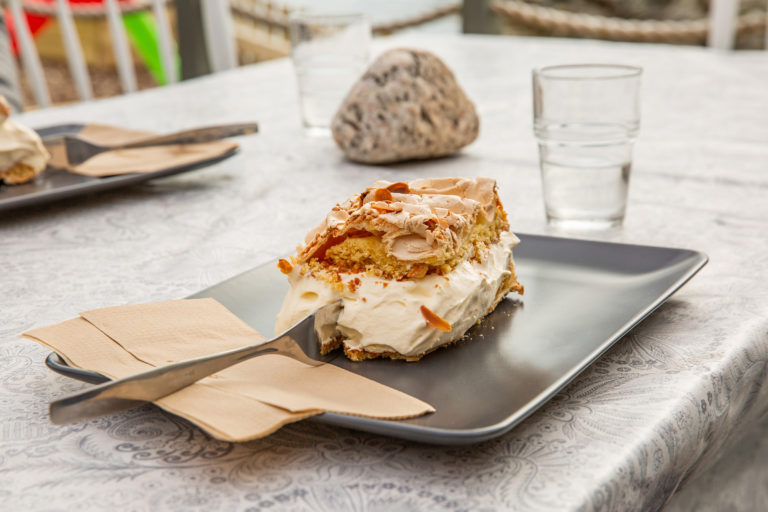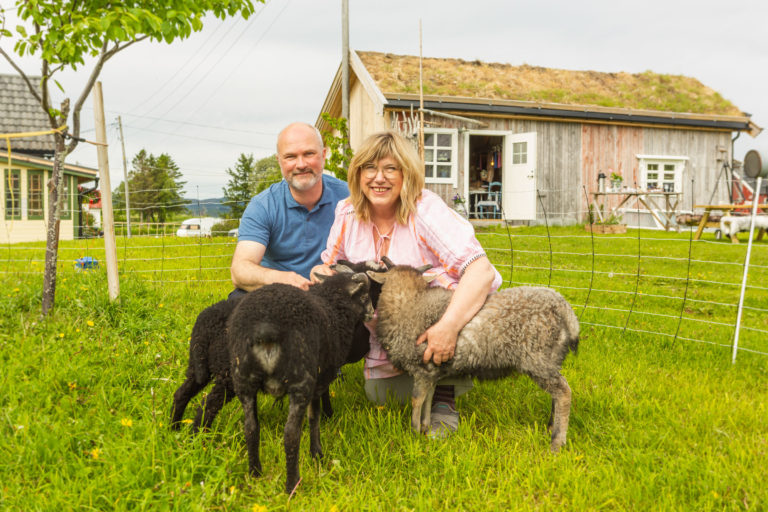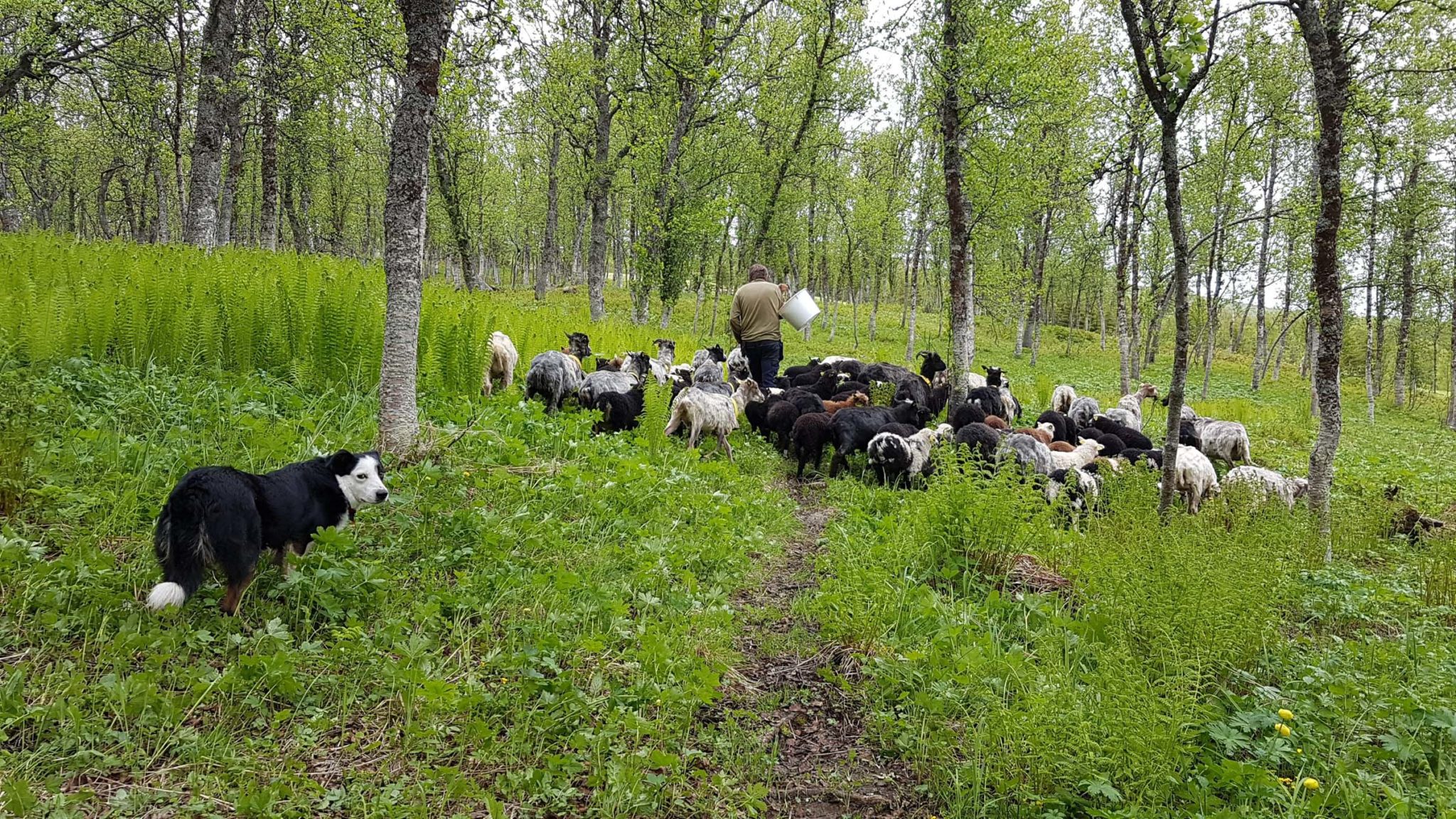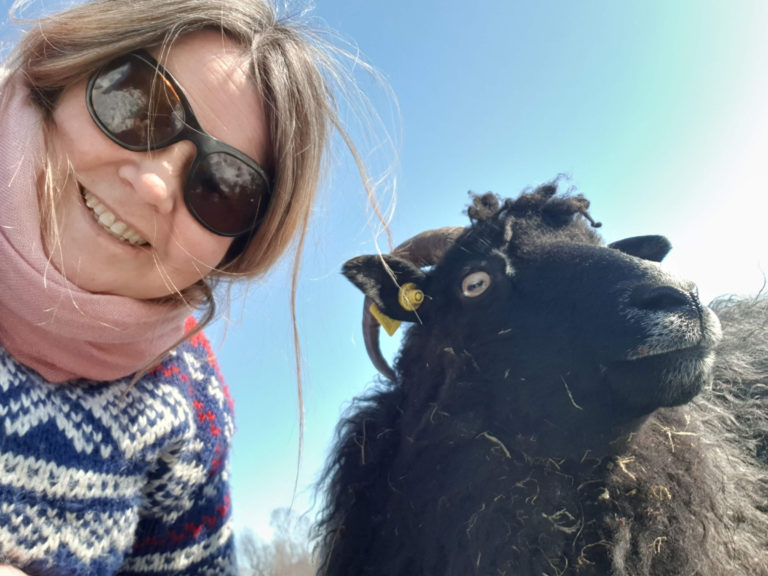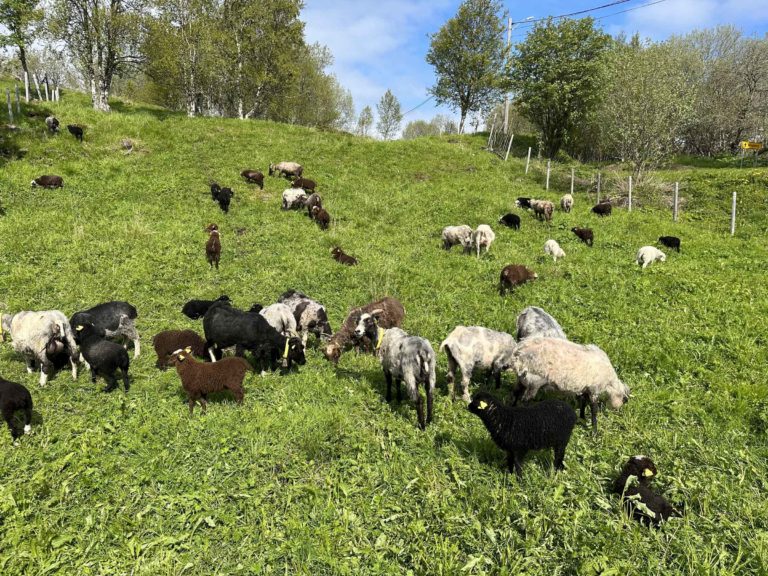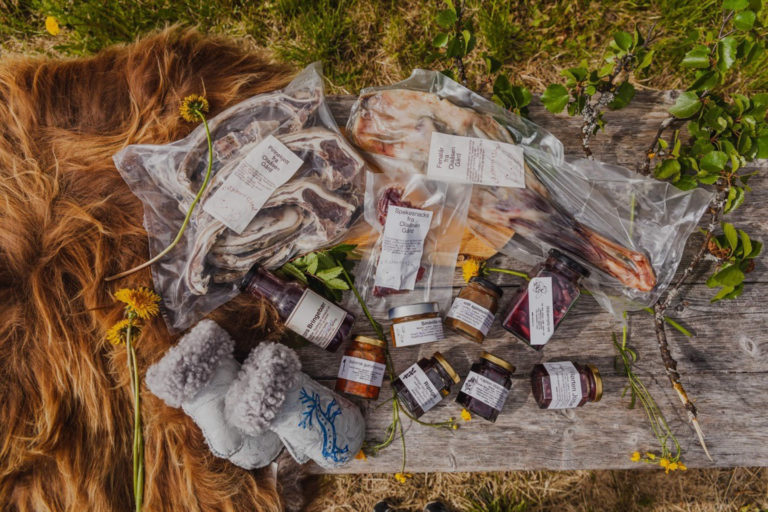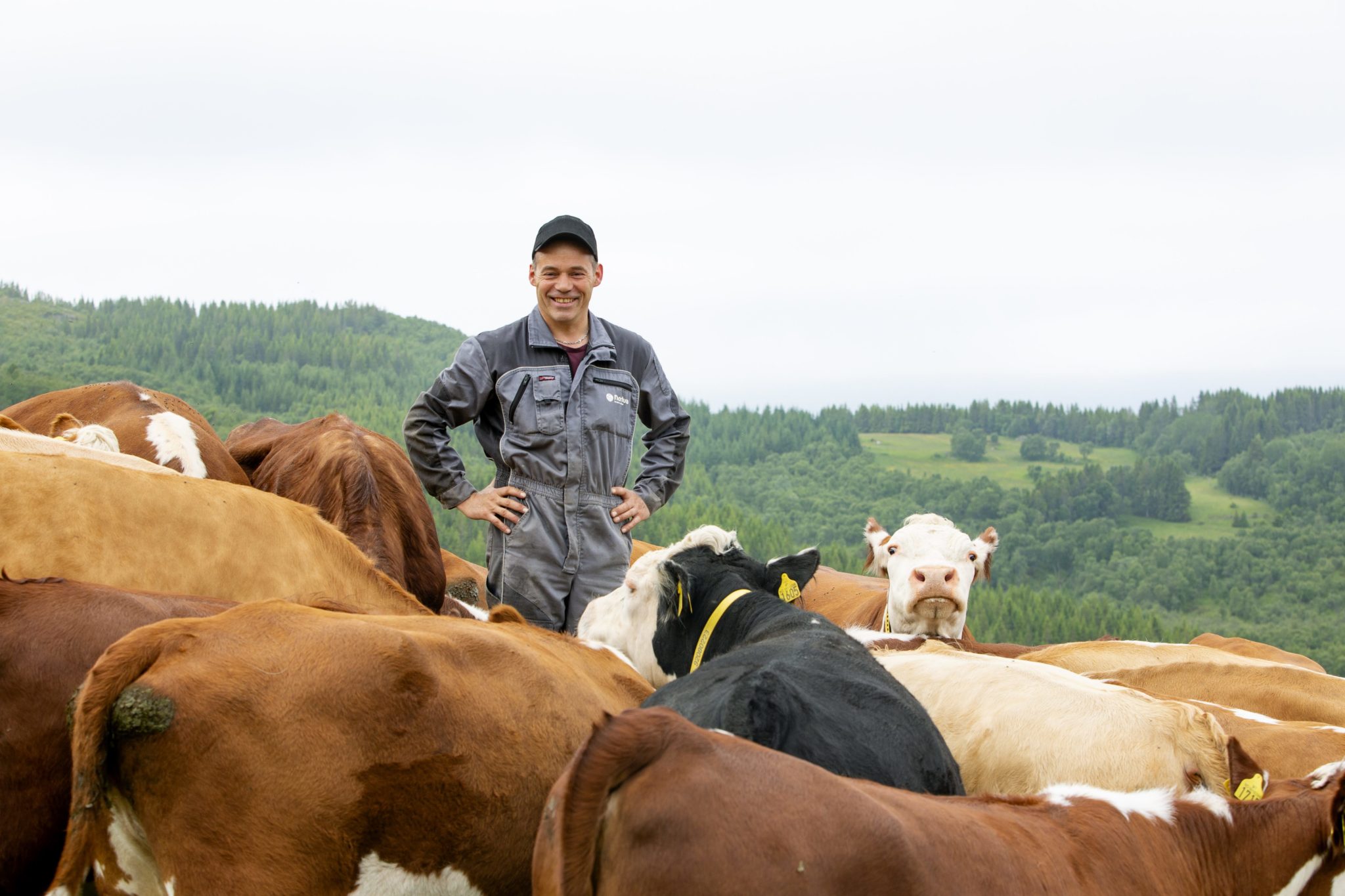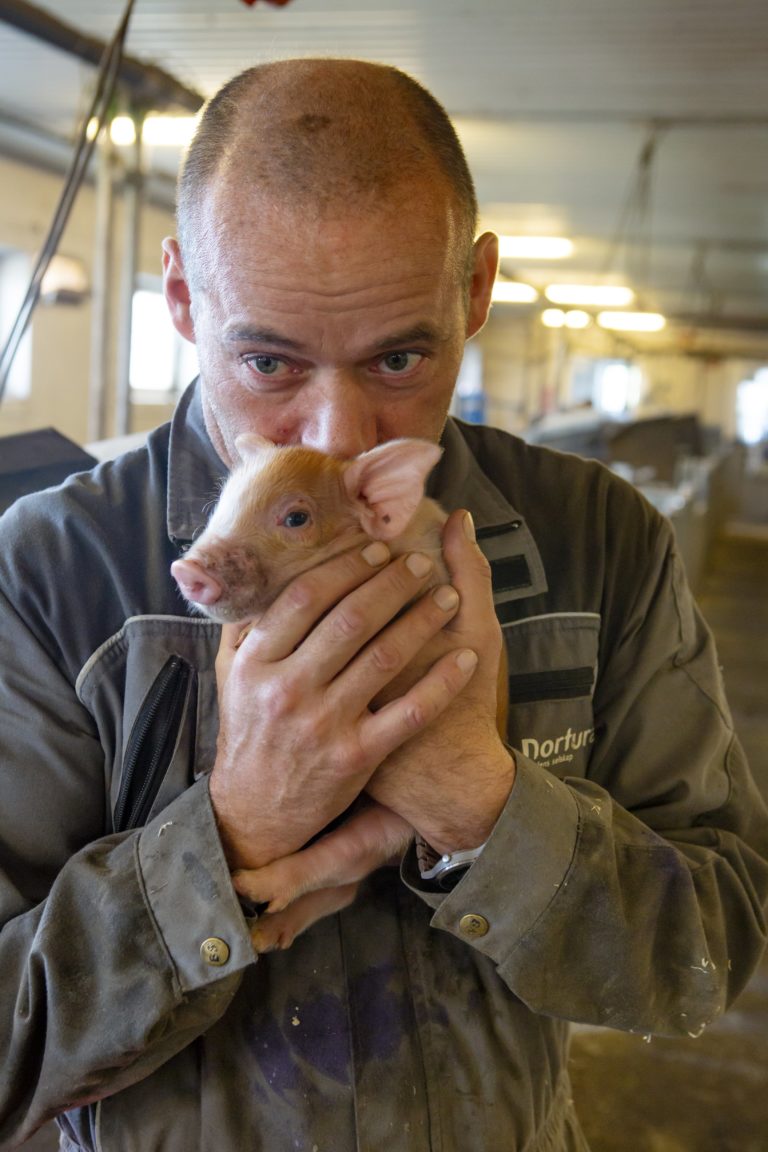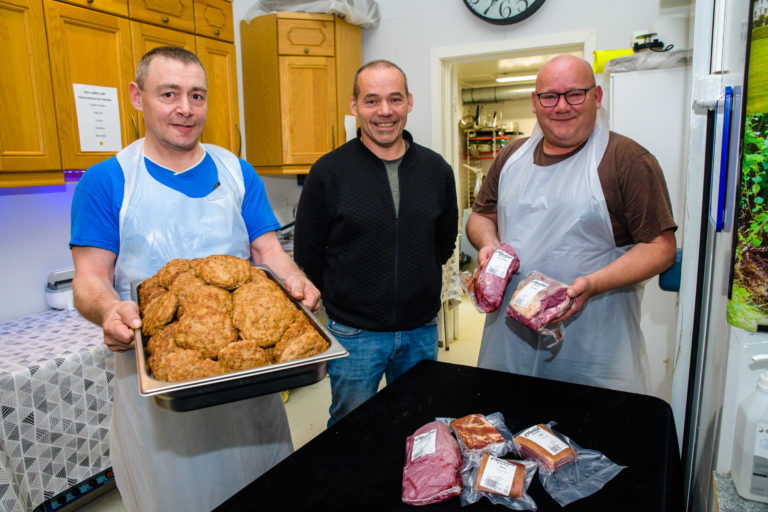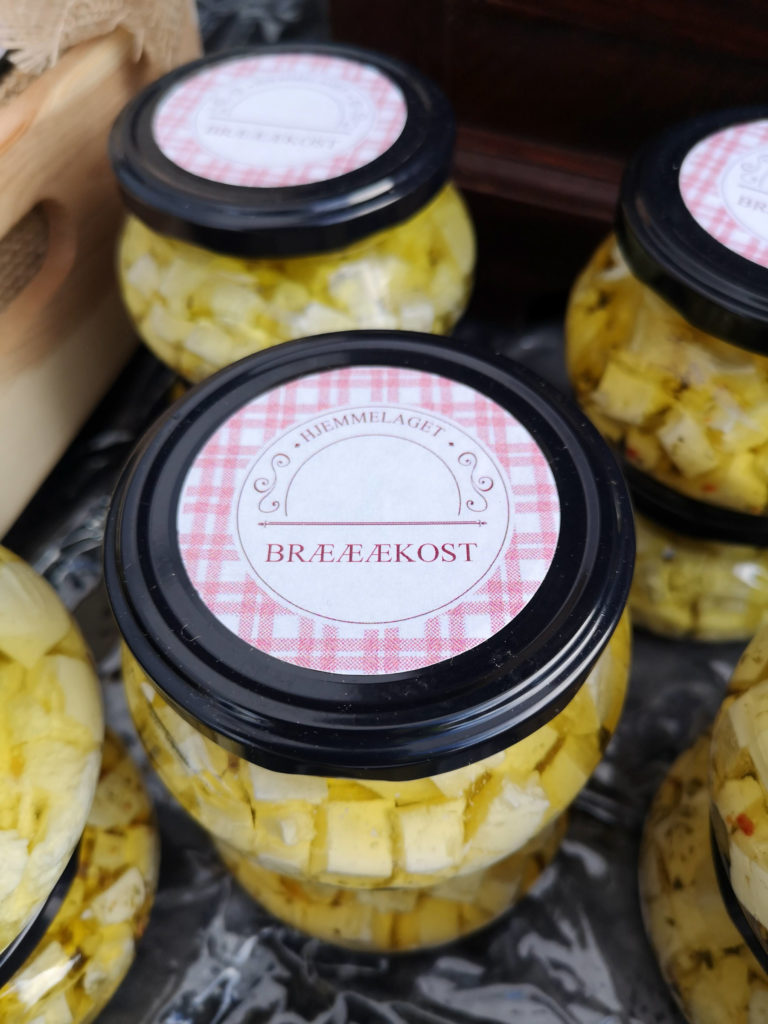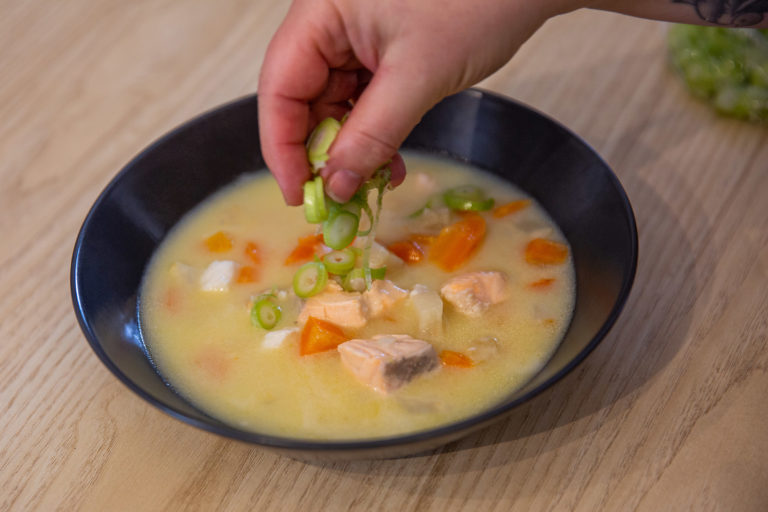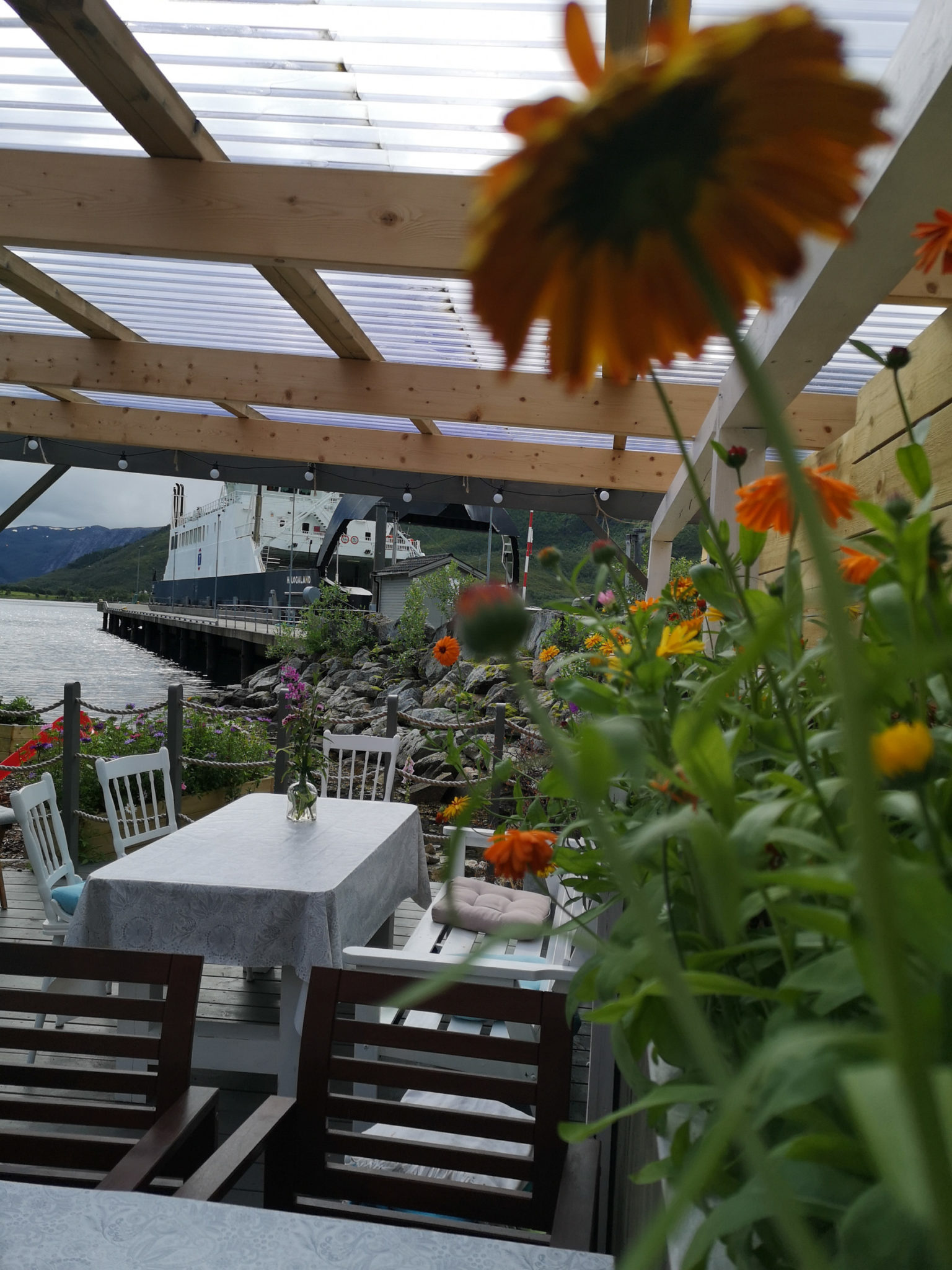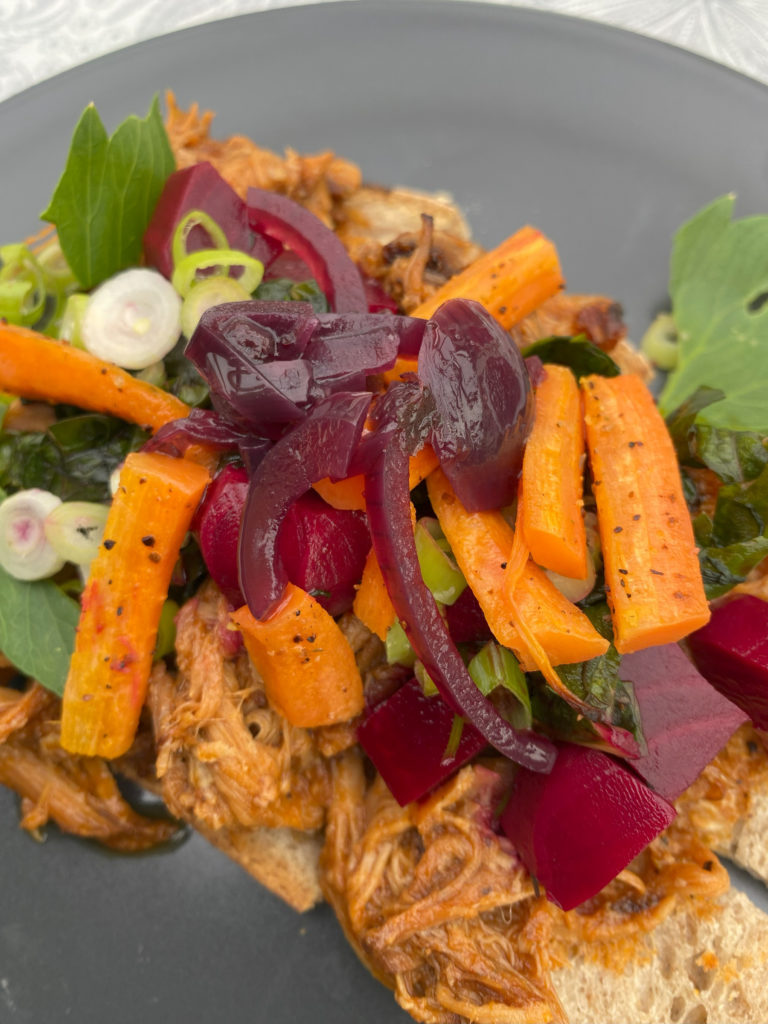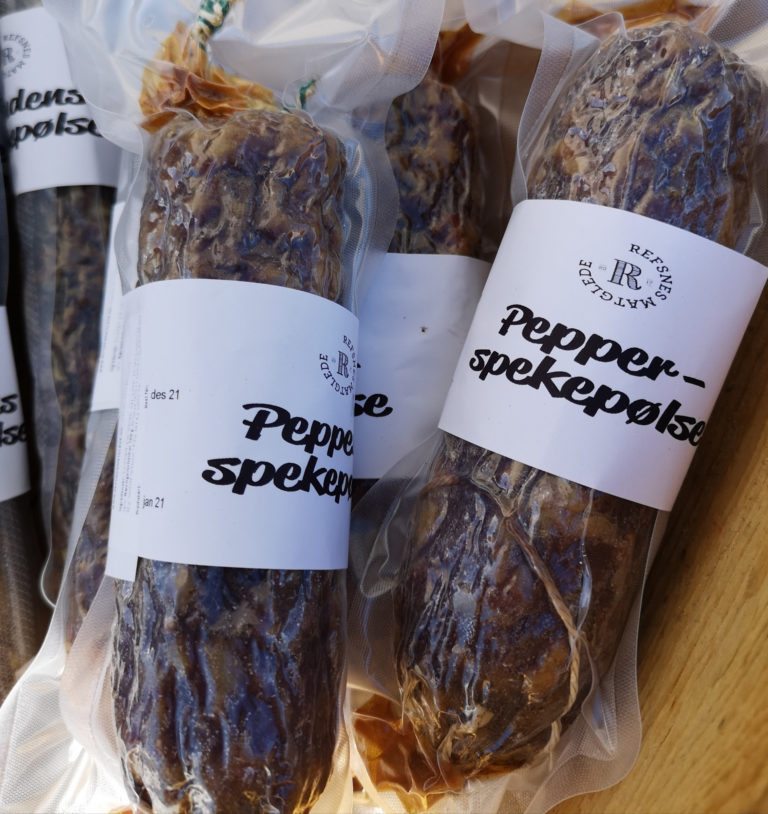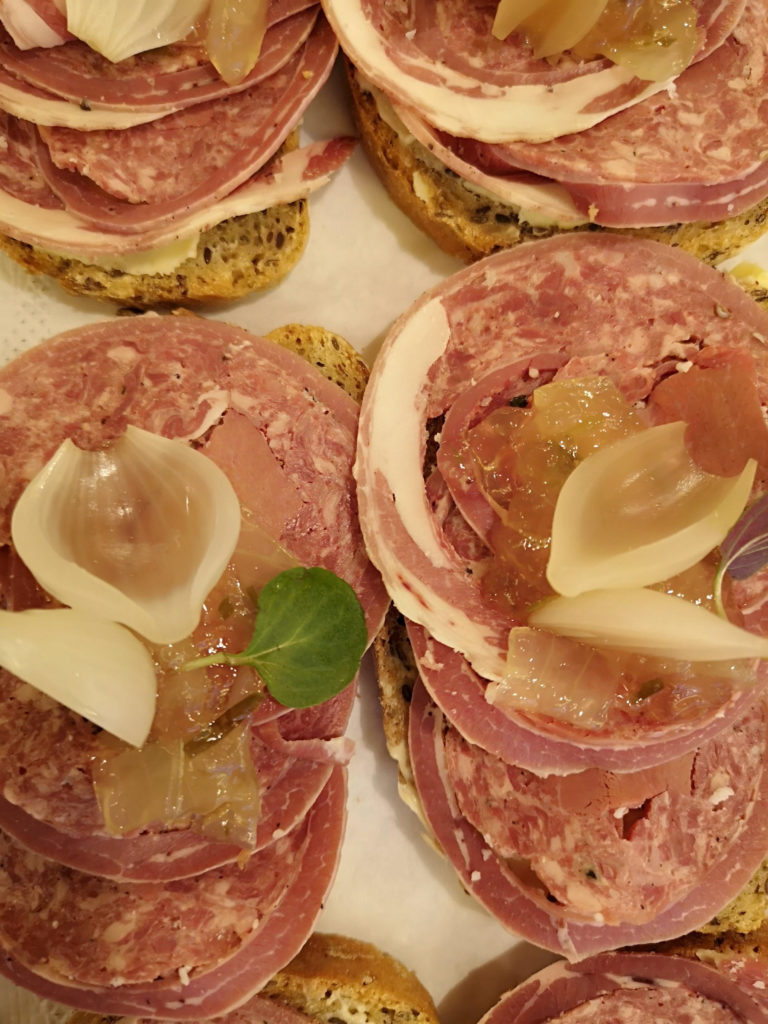The Harstad area is a land of plenty well inside the Arctic Circle. Come here for tasty cheeses, for cured meat from happy animals, for crunchy veg and sweet strawberries – and finish off with a sinful cake.
One tends to think of Northern Norwegian cuisine as a lot of fish and reindeer. There is some truth to it, but the area around Harstad is lush, green and with agricultural traditions going back thousands of years. This is your guide to fine dining, to great coffee breaks, to simple lunches and browsing through farm shops for tasty souvenirs. We start in the city of Harstad, and move north to the islands and then west to the lush meadows of Kvæfjord.
What foodstuffs are international travelers looking for?
A good place to start is the delicatessen Skafferiet (“The Pantry”) in downtown Harstad. I asked them, “what do international travelers buy?” And naturally, one looks for the exotic animals in the north; elk (moose) and reindeer, salted or smoked, in small packages are excellent gifts and souvenirs. They also have great cured sausages. Even internationally contentious whale meat, smoked, dried, and best served in thin slices, attracts a lot of attention. The bright orange molte – cloudberry – makes excellent jam.
What SHOULD international travelers look for?
Oh, that’s a different thing, “Skafferiet” claims. There is so much more”. On Grytøya island, the big goose population must be culled in early summer. This means goose meat can be marinated and dried into delicious morsels. Salted, dry cod from Kvæfjord can be made into Mediterranean fish specialties like “bacalao a la vizcaína” and “brandade”. Pesto made from Northern Norwegian victory onion – the garlic of the Vikings – is another specialty. Use it for your pasta or mix it with mayonnaise or butter as a condiment. Northern spices include lovage – traditionally linked with summer romance – and angelica. More surprising are birch leaf and spruce sprouts. Jams and jellies from the area are made from cloudberry, rhubarb, and blueberry.
Relax at the Skafferiet summer café in Harstad.
Placed on Harstad’s main square, Skafferiet is a good place to sit down in summer. A coffee with carrot cake from local carrots is irresistible. If fresh goose has come in, a goose burger is an excellent lunch option. A platter of local charcuterie is an afternoon treat. A lemonade-like drink from birch sap is healthy and fresh.” The locally sourced lefse – a flat, multilayered shortcrust pastry – is sometimes available. However, the shortcrust is made from potatoes, which is an old lefse ingredient making a comeback. Enjoy it with locally roasted coffee.
Eat your way around the Harstad area
Where do you go to eat in Harstad and Kvæfjord? We have made a tasty route from Harstad and towards the islands and through the Kvæfjord en route to the Vesterålen and Lofoten Islands. Do it all, do bits of it or just browse through the beautiful landscapes and see what turns up on your plate.
Downtown Harstad is a place to linger and eat
Upscale Bark Restaurant, young gourmet place Umami, humorous bakery Bakerinnen and well-stocked delicatessen Skafferiet; the colourful city centre of Harstad is a larder of good food.
Røkenes stately farm is steeped in history
Homely and local, yet a bit stately, the way a 250 year old farm should be.
The Courthouse at Sandsøy Island is cinnamon buns and mutton
Visit for the cinnamon buns in the “Tinghuset” and consider the fluffy sheep skins as a souvenir from Nordsand farm.
Olaåsen farm introduces you to Viking sheep
Get to know the Old Norwegian Sheep, and browse through their little farmshop
Ottestad gård and Elde gård sell DIY meat and veg
The little farmshop at Ottestad farm sells delicacies of happy calves and pigs. Elde farm next door specialised in tasty veg at the end of summer.
Hemmestad Brygge combines museum with cake
Small museum with lovely fish soup in summer. Don’t miss the Kvæfjord cake.
Dalheim gård makes inventive cheese
Sheep’s cheese? Give them a ring! Small scale farm with some delectable products.
Refsnes Matglede is local food on the terrace
Have lunch or cake before boarding the ferry on their sunny terrace or rainproof winter garden. They have a fun farmshop too.
Bark restaurant serves local produce in style
Nils Gjeitanger at Bark Restaurant in Harstad is also a fan of local produce. This modern and stylish, yet welcoming, place overlooks the fjord in Harstad. Reindeer from Refsnes and cured sausage from Ottestad feature on their much-loved tapas menu. “Today’s fish”, whether it’s cod, saithe, redfish, or halibut, is delivered by local fishermen. The meat mains are usually sourced from Ottestad in Kvæfjord. Local vegetables are primarily available late in the summer season, with carrots coming in full force in September. Strawberries, on the other hand, make their appearance on the menu in late July, closely followed by raspberries and currants.
Umami captures the season in every bite
The young chefs at Umami – occasionally cited as the reason to go to Harstad – follow the mood of the seasons. In the carefree days of early summer, they barbecue light veal, sprinkle it with the love herb lovage, and transform tender rhubarb sprigs into sour-sweet dessert magic. To complement these dishes, the wines are light and summery. After a few weeks of rest in July, their reopening is characterized by the abundance of late summer and autumn. Locals bring their mushroom baskets and allow the Umami staff to pick black and red currants in private gardens, one garden after another. Vegetables and homemade butter are sourced from the staff’s families. Their own potatoes are harvested in September, and then fresh game and mutton come into season. Heartier fare calls for more robust wines.
Røkenes serves up classic Northern Norwegian cuisine
Røkenes is a stately farm just a few minutes’ drive from Harstad, and the main house dates back to around 1750. Kristian Kulseng, the 10th generation to inhabit the farm, invites guests to his stylish yet homely barn restaurant. He grows his own herbs, smokes his own salmon and reindeer, dries his own fish for stockfish and ‘boknafesk’ (half-dried cod), and picks mushrooms and berries from the forest surrounding the farm. Long-standing connections provide him with greens from the vegetable gardens of Elde and Hundstad. Fishermen at Stornes deliver fresh fish, and from the Møkland farm, there is tasty mutton. In the summer, strawberry farmers on Grytøya Island provide midnight sun-ripened strawberries. As befitting an estate farm like Røkenes, the local produce is prepared with a touch of finesse from the French kitchen, just as landed proprietors would prefer it back in the day.
“The Bakeress” bakes some of the best buns in Norway
Coffee breaks are not a joking matter in Norway, although plenty of jokes are involved. Bakerinnen – liberally translated into ‘The Bakeress’ – is a Harstad favourite when meeting up with friends for strong coffee, a sweet temptation, and lots of banter. There is no lack of featherlight croissants and decadent cream cakes, but for that authentic Scandi coffee break feel, you should go for the buns. A generously sized spiral cinnamon bun, or its surprising cardamom sibling, is coffee break heaven. The skolebolle is a slightly vulgar relative, filled with vanilla custard and drizzled with coconut glaze.
Make a sheepish visit to the old courthouse at Nordsand gård
On the island of Sandsøy, the Tinghuset – an 18th-century courthouse – functions as an impromptu café. The cinnamon buns are to die for, and coffee is served in old cups with rose petals out on the lawn. There is also a small farm shop. The farm itself, Nordsand gård, specialises in Old Norwegian Sheep, a heritage breed with marbled meat and rasta-like long wool. ‘Bokna’ mutton means it has been salted and hung for two to three weeks, creating a tasty, tender meat. Consider buying some if you’re homeward bound, or perhaps one of the soft, perfectly tanned sheepskins for your sofa. Or just have another cup of coffee.
Kvæfjord is the epicentre of Norwegian baking
When you head over to Kvæfjord, west of Harstad, you’re in for a treat. The Kvæfjord Cake has been voted Norway’s national cake and is tremendously popular everywhere in Norway. However, the grandmother of today’s farmer at Ottestad farmstead ran a fine pâtisserie in Harstad just before the war with her sister. Here, by adapting a Danish recipe, she developed Kvæfjordkaka – the “Kvæfjord cake”. It consists of layers of meringue infused with almonds and vanilla, with whipped vanilla or rum cream in between. Deliciously crusty and sinfully creamy, this cake has it all. Eat it in its authentic state in homely places, or go for the refined variety at upscale places.
How could the Vikings conquer the world? They had the best sheep!
The spælsau – or Norwegian Short Tail Landrace – is the sheep of the Vikings. Unique among breeds, it produces two kinds of wool, one light and fluffy, the other coarse and solid. On Viking ship sails, the warp was made from the coarse wool, while the fabric itself was made from the finer wool. This made the sails strong and water resistant, a key factor for sea marauders. These sails were used not only by the Vikings, who were present for around 200 years, but also by fishermen and traders over a much longer period. At Olaåsen farm in Kvæfjord, you can learn the whole spælsau story on an informal little walk, and there is plenty of opportunity to scratch the sheep a little bit, causing them to shed their wool naturally.
The Olaåsen blueberry jam comes with a little twist
The little shop at Olaåsen sells tempting tidbits that you could take home, like pickled onions with blueberry or blueberry jam spiked with a dash of Captain Morgan rum. The lammerull – lamb roll – is a favorite in the north and can be brought along as a snack when traveling, while the cured lamb sausage makes for a perfect souvenir. The wool seat pads featuring motifs from the medieval church of Trondenes are courtesy of the sheep grazing around this landmark church. The naturally varied colors of the sheepskins match well with a modern interior. If you stay for lunch, the burgers are made from mutton and elk.
Ottestad gård is the home of happy animals
Meat tastes so much better when the animals have had a happy life. Calves at Ottestad farmstead get to spend all summer grazing on flower meadows in the hills above Kvæfjord. Some of their pigs get to be out and dig holes in the ground, the way pigs are supposed to. The happiness is felt in their cured sausages and bacon, and their “calf snacks” – a young version of beef jerky. Give them a little hint ahead, and they open their farm shop on short notice
Hemmestadbrygga is a tasty museum visit
An ochre house, built on stone columns on the fjord, serves as an old shop and trading post. Located along the midsection of the fjord in Hemmestad, it could be reached by traditional boats with high bows and sterns from everywhere. The old shop is well-preserved, with exhibits on fish trade, the women of the coast, and even a separate exhibit on herring and potatoes. This is a great place for lunch in the summer, offering locally made fish soup and the delicious Kvæfjord cake for dessert
Sheep’s cheese is a novelty in Norway
No sheep’s cheese in Norway, you say? But we see sheep all over the place! The multi-generational Dalheim farm decided to change that. They produce the firm, matured Dalheimer. Another favorite is the mixed cow and sheep variety, Mor Åse, named after the grandmother on the farm. The Viking-inspired fresh cheese Geirlaukr is spiced with ramslauk, or wild garlic. They also have their own take on halloumi, and their feta-like salad cheese is also much appreciated. As a small-scale producer, their cheese is often sold out. The best bet is to give them a ring when heading towards the Refsnes ferry dock. Then they can often open up their small farm shop with cheese and cured mutton sausage. If you’re absolutely sheep crazy, call them a bit ahead for a visit at their summer farm and help out with the milking
Hope you miss the ferry, then you can enjoy Refsnes Matglede
The café at Refsnes ferry dock (often spelled Revsnes), Refsnes Matglede, offers a refreshing change from standard terminal cafeterias. Their inviting terrace – with a backup winter garden for rainy days – is the spot for lunch. Today’s special could be an elk burger in homemade focaccia, cold salmon with cucumber salad and sour cream, or local game bratwurst. Check their Facebook page for details. No commercial sodas; try their homemade mint lemonade instead. Enjoy Lofoten-roasted coffee with Kvæfjord cake or one of their three fresh cakes. Locals often frequent the café, known for its welcoming atmosphere. Take home edible souvenirs from their delicatessen, like Austerfjord blueberry jam, cloudberry jelly, elk ham, reindeer salami, and juniper berry jelly. All sourced within 75 km from Refsnes.
Where to eat in Harstad and Kvæfjord
Harstad is a city in Northern Norway, almost 300 km inside the Arctic Circle, of some 25 000 inhabitants. Travellers heading to the well-known Lofoten Islands can make an easy detour to Harstad.
It could be a good idea to book ahead, especially for upmarket places like Bark, Umami and Røkenes. Small-scale farmshops can often be closed, but a quick ring en route can often open on short notice. Informal lunch and coffee places usually don’t require any bookings.
True. Harstad and Kvæfjord are well off the beaten tourist track, and the small farm shops sell mostly to locals. Look at the photos, press “kontakt” for contact info and give them a ring, you will find that most people speak passable to excellent English. The extra effort is often very rewarding.
Haha, if you can’t eat local food, Harstad has a selection of Asian food, pizza and other comfort foods. But you’ll miss out on some great delicacies.
Harstad has a good selection of places to stay, often at competitive prices. Downtown, a host of comfortable chain hotels are found, and in the area around, you find a fair bit of character. Study the website of Visit Harstad.
Harstad has a number of historic sites, concentrated on the peninsula of Trondenes. These can be seen leisurely in a day, and are reached on foot by a lovely path. There is also a number of hikes, mostly of the not-too-demaning type, offering great views of the landscapes. North of Harstad, there is a myriad of islands with a great history, and the lush and green Kvæfjord in the west is considered the larder of Northern Norway. Visit Harstad has the full overview on their website.
You certainly can! The Harstad/Narvik airport , locally known as Evenes, less than an hour away has international flights part of the year, and several connections to Oslo with Norwegian Air and SAS.
Lofoten’s capital Svolvær is a scenic two hour drive from Harstad. There are also buses. You can also easily combine with the islands of Vesterålen in the west, most notably the whale watching at Andenes or Stø.
Tromsø’s many international connections make it a gateway to the north. From Tromsø, there is a 3 hour catamaran ride to Harstad. Driving means an inland detour, taking some 5 hours on good roads. Anyone travelling between Tromsø and Lofoten should consider pausing in Harstad. Except if you’re on a diet.
